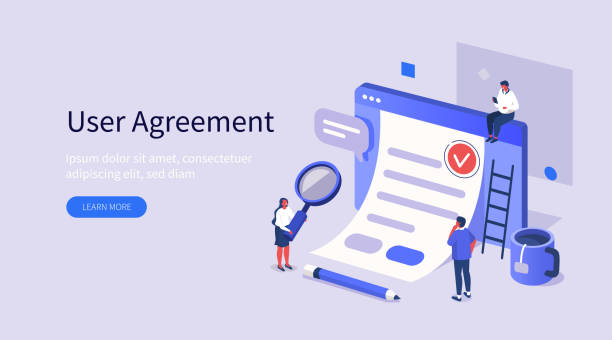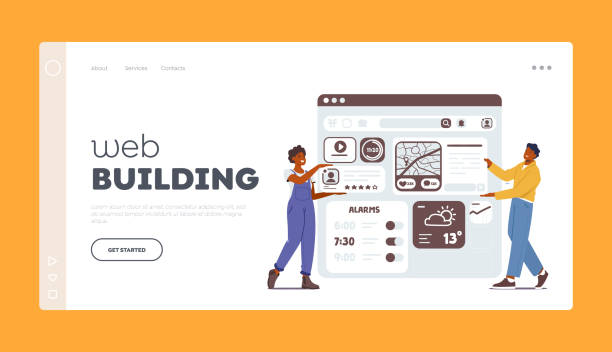Introduction to SEO-Optimized Website Design and Its Importance

In today’s digital age, having a website is not merely an option, but an undeniable necessity.
However, simply having a site is not enough; that website must be #designed and #optimized in such a way that it is visible in search engines like Google.
This is where the concept of SEO-optimized website design comes into play.
An SEO-optimized website is a site that is structured technically, content-wise, and from a user experience perspective in such a way that search engines can easily crawl, index, and rank it highly.
The importance of this issue is due to the massive volume of daily searches; users constantly utilize search engines to find the services, products, and information they need.
If your site does not appear in the initial results, it will effectively remain invisible to a large portion of potential audiences.
SEO-optimized website design goes beyond merely using keywords.
It is a comprehensive approach that includes technical aspects, content strategy, user experience, and link building.
Without a website with an optimized structure and content, even the best digital marketing strategies may not yield the desired results.
In fact, SEO (Search Engine Optimization) is a process that helps your site stand out among competitors and attract more organic (natural) traffic.
Organic traffic, due to its targeted nature, usually leads to higher conversion rates; because users who reach your site through search have already shown interest in your topic or services.
This section serves as an educational introduction to understanding the foundations of this field and will pave the way for more specialized topics later.
In addition to attracting traffic, good SEO also brings credibility and trust to your brand.
Websites that rank highly in search results appear more authoritative and trustworthy in the eyes of users.
This, in turn, helps increase brand awareness and create a positive image in the minds of the audience.
Ultimately, investing in SEO-optimized website design is a long-term investment that not only yields significant returns but also helps you establish your position in today’s competitive market.
In the following, we will delve deeper into the various components and techniques of this process to assist you in achieving a powerful and high-performing website.
Did you know that your website is the first impression customers get of your company? Multiply your business’s credibility with a powerful corporate website from Rasavab!
✅ Custom and eye-catching design tailored to your brand
✅ Improved user experience and increased customer acquisition
⚡ Get a free consultation!
Fundamentals of Technical Website Optimization

One of the main pillars of SEO-optimized website design is technical optimization.
#Technical_SEO includes all actions taken to help your site be better #crawled and #indexed by search engines.
The first step in this regard is ensuring a healthy URL structure.
Short, readable URLs containing relevant keywords are beneficial for both users and search engines.
Using an XML Sitemap is also crucial; this map helps search engines discover and index all important pages of your site.
The Robots.txt file also tells search engines which sections not to crawl, which can be very effective in managing the crawl budget.
Site loading speed is a very important ranking factor.
Users and search engines alike hate slow sites.
To increase speed, you should optimize images, use browser caching, compress CSS and JavaScript files, and utilize a reputable and high-speed hosting provider.
Tools like Google PageSpeed Insights can help you identify speed issues.
Site information architecture is another key aspect.
The navigation structure should be clear, logical, and hierarchical so that users and search engine crawlers can easily move around your site.
Using breadcrumbs can also help improve user experience and SEO.
Securing your site with the HTTPS protocol (using an SSL certificate) is a direct Google ranking factor and increases your site’s credibility.
Also, ensuring mobile-friendliness is of high importance, as Google uses a Mobile-First Indexing approach.
This means that the mobile version of your site will be used for ranking.
Generally, SEO-optimized website design requires meticulous attention to technical details, which makes this topic highly specialized.
Solving technical issues can have a significant impact on improving rankings and attracting traffic.
These are fundamental principles for any website that wants to lead in digital competition and provide a flawless experience not only for search engines but also for users.
The Role of Content in SEO-Optimized Website Design and Keyword Strategy

Content is king, and this statement holds true more than ever in the world of SEO.
A significant portion of SEO-optimized website design is dedicated to content creation and optimization.
#Quality, #relevant, and #valuable_content not only attracts users but also signals to search engines that your site is an authoritative and reliable source.
The first step in content strategy is keyword research.
You need to know exactly what your target audience is searching for.
Tools like Google Keyword Planner, Ahrefs, and Semrush can help you find high-volume and low-competition keywords.
After identifying keywords, you should create content that naturally incorporates these words.
Avoid keyword stuffing, as this not only harms your SEO but also disrupts the user experience.
Your content should be comprehensive and in-depth, covering all aspects of the discussed topic.
Try to answer potential user questions and provide information beyond the usual level.
Content types include blog posts, product pages, service pages, FAQ pages, and even videos and infographics.
Variety in content format can also help attract different audiences.
On-Page optimization is also a vital part of the content strategy.
This includes the correct use of Title Tags, Meta Descriptions, Heading Tags (H1, H2, H3), and Image Alt Text.
Each of these elements helps search engines better understand your page’s content.
For example, the title tag should contain the main keyword and be engaging to encourage users to click.
Thought-provoking content can also increase engagement rates and keep users on the site longer.
This is an educational and explanatory approach that highlights the importance of quality content in the SEO-optimized website design process.
Some types of effective content for SEO:
| Content Type | Description | SEO Goal |
|---|---|---|
| Long Blog Posts | In-depth exploration of topics, answering complex questions | Ranking for long-tail keywords, increasing authority |
| Comprehensive Guides (Ultimate Guides) | Complete source of information on a specific topic | Establishing authority, attracting backlinks |
| Videos and Infographics | Engaging and shareable visual content | Increasing dwell time, social sharing |
| Case Studies and Whitepapers | Specialized and data-driven content | Proving expertise, attracting B2B audiences |
User Experience (UX) and Its Impact on SEO

In recent years, search engines have increasingly emphasized #user_experience (UX) as a ranking factor.
SEO-optimized website design is incomplete without attention to UX.
Google and other search engines aim to provide the best possible experience to their users, so it’s logical that websites offering an excellent user experience achieve higher rankings in search results.
Factors such as ease of navigation, layout clarity, text readability, and page loading speed all impact UX.
If users quickly leave your site (high bounce rate), this is a negative signal for search engines.
Good UX means that users can easily find the information they need and achieve their goals on the site.
This includes responsive design for all devices, using readable fonts, sufficient white space to prevent clutter, and clear Call-to-Action (CTA) buttons.
Google’s Core Web Vitals (including LCP, FID, CLS) are also metrics that directly measure site UX and affect SEO rankings.
Optimizing for these metrics is an important part of the SEO-optimized website design process.
Additionally, engaging and interactive content can help improve UX.
Videos, image galleries, surveys, and comment sections encourage users to spend more time on your site and engage more.
This increased dwell time and reduced bounce rate send positive signals to search engines.
Remember that the ultimate goal of SEO is to provide the best and most relevant answer to a user’s search, and this is achieved with a flawless user experience.
This section provides you with an analytical view of the relationship between UX and SEO and emphasizes the importance of placing the user at the center of the SEO-optimized website design process.
Are you annoyed by losing customers who visited your site to buy?
Rasavab is your specialized solution for a successful online store.
✅ Significantly increase your online sales
✅ Build trust and professional branding with customers⚡ Get a free consultation from Rasavab specialists!
Link Building and Domain Authority in SEO-Optimized Website Design

Link Building is one of the important ranking factors in SEO and plays a significant role in SEO-optimized website design.
#Backlinks (links from other sites to your site) act like votes of confidence.
The more authoritative and relevant sites link to you, the more your site’s Domain Authority increases in the eyes of search engines.
However, the quality of links is more important than their quantity.
One backlink from a high-authority site relevant to your field of activity is worth far more than dozens of links from low-quality or spammy sites.
There are various link-building strategies.
Creating valuable and shareable content (linkable content) is one of the best ways to naturally attract backlinks.
This includes infographics, case studies, original data, and comprehensive guides.
Activity on social networks and encouraging users to share your content can also help increase visibility and, consequently, attract backlinks.
In addition to external backlinks, internal linking is also highly important.
Linking from relevant pages within your own site to each other helps search engines better understand your site’s structure and distributes authority (Link Juice) throughout the site.
Correct use of Anchor Text – the text where the link is placed – is also important.
Anchor text should be relevant to the destination page and contain the target keyword.
However, you should avoid overusing exact-match anchor texts to appear natural.
Ignoring broken links and incorrect redirects can also harm your SEO.
Tools like Google Search Console can help you identify these issues.
This section provides specialized guidance for understanding the Off-Page aspects of SEO, which complements the On-Page and technical sections in SEO-optimized website design.
Mobile Optimization and Loading Speed in SEO-Optimized Website Design

As mentioned earlier, mobile optimization and loading speed are two critical factors in SEO-optimized website design.
Given the increasing number of internet users via mobile devices, Google has adopted the #Mobile-First_Indexing approach years ago.
This means that the mobile version of your site will be Google’s primary reference for crawling, indexing, and ranking your site.
Therefore, responsive design, which automatically adjusts your site to the user’s device screen size, is essential.
Ensuring that all elements, buttons, and forms work correctly and are accessible on the mobile version is of paramount importance.
Site loading speed is also very important, not only for SEO but also for user experience.
Research has shown that users expect a website to load in less than three seconds, and otherwise, many of them leave the site.
To improve loading speed, in addition to the technical tips mentioned in previous chapters (image optimization, caching, code compression), using Content Delivery Networks (CDNs) can also be very effective.
CDNs store copies of your site on various geographical servers, delivering content from the server closest to the user and minimizing latency.
JavaScript and CSS codes can cause render-blocking, which reduces loading speed.
Optimizing and deferring the loading of these files can be helpful.
Additionally, database optimization, reducing the number of redirects, and using next-gen image formats like WebP, which have smaller file sizes, are other effective solutions for increasing site speed.
This section provides specialized and explanatory guidance on the performance aspects of SEO-optimized website design that directly impacts user satisfaction and search engine rankings.
Tools and Data Analysis in SEO

SEO-optimized website design and its maintenance is an ongoing process that requires careful monitoring and data analysis.
#SEO_tools help you evaluate your site’s performance, identify issues, and discover new opportunities.
Google Search Console (GSC) is an essential and free tool that provides vital information about how your site performs in Google Search.
This tool shows you which keywords your site ranks for, which pages have indexing issues, and if there are errors like broken links.
Google Analytics (GA) is also a powerful tool for analyzing user behavior on your site.
Using GA, you can see information such as the number of visitors, time spent on site, bounce rate, traffic sources, and user navigation paths.
This data provides valuable insights for improving your user experience and content strategy.
Combining GSC and GA data gives you a comprehensive view of your site’s SEO performance and enables data-driven decision-making.
In addition to Google’s tools, there are other powerful commercial tools such as Ahrefs, Semrush, Moz, and Majestic, which offer more advanced capabilities like keyword research, competitor analysis, backlink analysis, and technical site health checks.
Using these tools for more precise and in-depth analysis is essential in the SEO-optimized website design process.
Monitoring keyword rankings, analyzing organic traffic, and evaluating content performance help you adjust your strategies and continuously improve your site’s SEO.
This section, as an analytical and educational guide, highlights the importance of being data-driven in SEO.
Comparison of features of some key SEO tools:
| Tool | Main Strengths | Main Use in SEO |
|---|---|---|
| Google Search Console | Direct data from Google, free, site technical issues | Monitoring search performance, identifying errors, indexing status |
| Google Analytics | User behavior analysis, traffic sources, goals and conversions | Understanding user interactions, UX optimization, campaign tracking |
| Ahrefs | Strongest in backlink analysis, keyword research, competitor analysis | Link building strategy, finding content opportunities |
| Semrush | Comprehensive tool with keyword research, PPC, local SEO, competitor analysis | Planning complete SEO strategy, content marketing |
Challenges and Future Trends in SEO-Optimized Website Design

The world of SEO is constantly evolving, transforming #SEO-optimized_website_design into a dynamic field.
New challenges such as the increased use of Artificial Intelligence in search engines (like Bard and ChatGPT), voice search, and the growing importance of E-E-A-T (Experience, Expertise, Authoritativeness, Trustworthiness) have reshaped the SEO landscape.
AI-generated content can be produced quickly and at scale, but the main challenge is whether this content can be “human” and “useful” enough to pass Google’s quality filters?
Voice search is also gaining popularity and changing keyword strategy.
Users in voice search tend to use natural language and full questions rather than short, keyword-based phrases.
This means your content needs to be optimized to answer these types of questions.
Additionally, Local SEO has become more important for physical businesses, with platforms like Google My Business playing a vital role in the visibility of these businesses.
News and new trends in this area can have significant impacts on future strategies.
The E-E-A-T concept highlights the importance of the expertise and authority of the author and content source.
Google seeks content provided by credible individuals or organizations with real-world experience in that field.
This means greater transparency about authors, providing authoritative sources, and demonstrating expertise in the relevant domain.
With these changes, simply creating content is not enough; you must produce content that demonstrates authority and trust.
This section provides an analytical and news-oriented perspective on the future of SEO-optimized website design, indicating that success in SEO requires flexibility and continuous updates to knowledge and strategies.
Does your current e-commerce website design lead to lost customers and sales?
Rasavab is your solution with modern and user-friendly e-commerce website designs!
✅ Significant increase in conversion rates and sales
✅ Strong branding and building customer trust
⚡ Get a free e-commerce website design consultation from Rasavab!
Common Mistakes in SEO-Optimized Website Design and Solutions

On the path to SEO-optimized website design, common mistakes exist that can render your efforts fruitless.
#Identifying and #avoiding these mistakes is essential for long-term success.
One of the most common errors is neglecting technical SEO.
Even the best content will not be seen if your site is not properly crawled and indexed by search engines.
The solution is to regularly check your site technically with tools like Google Search Console and fix crawl errors, indexing issues, and slow speeds.
Another mistake is keyword stuffing.
In an attempt to rank quickly, some webmasters unnaturally repeat keywords in their content.
This not only disrupts the user experience but can also lead to Google penalties.
The solution is to use keywords naturally and in the appropriate context, focusing on providing value to the user.
Ignoring search intent is also a big mistake.
If your content doesn’t answer what users are truly looking for, you will never achieve high rankings.
You need to create content that directly addresses the user’s need and intent.
Lack of mobile optimization is another mistake that, given Google’s Mobile-First Indexing, can be disastrous.
Ensuring responsive design and appropriate loading speed on mobile devices is crucial.
Also, purchasing backlinks from spammy or irrelevant sites is one of the most dangerous link-building mistakes that can lead to severe penalties.
Always seek natural and high-quality backlinks from reputable sources.
This section guides you to avoid these mistakes and proceed with your SEO-optimized website design process in the best possible way, and I use thought-provoking content in this area to stimulate critical thinking.
Summary and Next Steps for Success in SEO-Optimized Website Design

As you have learned throughout this article, SEO-optimized website design is a complex and multifaceted process that requires attention to technical details, content strategy, user experience, and link building.
#SEO is not a one-time project but a #continuous and #dynamic effort that must be constantly updated and optimized as search engine algorithms and user behavior change.
Success in SEO means building a website that is optimized for both search engines and users.
Your next steps to ensure success in SEO-optimized website design include the following:
- Regular Monitoring: Continuously monitor your site’s performance with tools like Google Search Console and Google Analytics.
- Content Updates: Update your old content and produce new, high-quality content relevant to new keywords.
- Competitor Analysis: Analyze your competitors’ SEO strategies and draw inspiration from their strengths.
- Building Quality Links: Continuously seek new opportunities to acquire natural and authoritative backlinks.
- Staying Updated with Changes: Stay informed about the latest SEO news and trends and adjust your strategies accordingly.
Remember that SEO is a marathon, not a sprint.
Results may not appear immediately, but with perseverance and the right approach, your SEO-optimized website design will yield excellent results in the long run and help you achieve your business goals.
This section, as an explanatory and engaging summary, provides a clear path for your continued journey in the world of SEO.
By focusing on quality, user experience, and adhering to SEO principles, you can solidify your position in search results and benefit from organic traffic.
Frequently Asked Questions
| Question | Answer |
|---|---|
| What is SEO-optimized website design? | Designing a website that is optimized for both users and search engines to achieve higher rankings. This includes adhering to technical, content, and user experience principles. |
| Why is SEO important in website design? | The importance of SEO in website design stems from its ability to increase site visibility in search results, attract organic traffic, improve user experience, and build user credibility and trust. |
| What are the most important elements of SEO-friendly website design? | Responsiveness (mobile-friendliness), high loading speed, clear navigation structure, proper use of heading tags (H1-H6), image optimization, and quality content. |
| What is the impact of responsiveness (mobile-friendliness) on SEO? | Google uses mobile-first indexing, meaning it prioritizes the mobile version of websites for ranking. Therefore, responsiveness is vital for SEO. |
| What is the role of site speed in SEO? | Faster websites provide a better user experience, reduce bounce rates, and are favored by search engines. Site speed is one of Google’s ranking factors. |
| How to optimize images for SEO? | By compressing image file sizes, using descriptive and relevant file names, and most importantly, writing appropriate and content- and keyword-relevant Alt Text. |
| What is the importance of content in SEO-centric design? | Quality, relevant, and keyword-rich content is crucial for attracting and engaging users, as well as for ranking in search engines. Content is the king of SEO. |
| How does URL structure affect SEO? | Clean, descriptive, short URLs containing keywords help users and search engines better understand page content and appear in search results. |
| What is Schema Markup and what is its role in SEO? | Schema Markup is structured data that helps search engines better understand site content and display it as Rich Snippets in search results, which increases the click-through rate (CTR). |
| Should SEO be considered from the beginning of website design? | Yes, it is highly recommended. Integrating SEO principles from the initial phase of website design saves time and cost and leads to better and more sustainable long-term results. |
And other services of Rasavab Advertising Agency in the field of advertising:
Smart SEO: Transform user engagement with the help of real data.
Smart Google Ads: A combination of creativity and technology to improve SEO ranking through custom programming.
Smart Website Development: A creative platform to improve user interaction with marketing automation.
Smart Social Media: An effective tool for online growth with the help of marketing automation.
Smart Direct Marketing: Designed for businesses seeking online growth through attractive user interface design.
And over hundreds of other services in the field of internet advertising, advertising consultation, and organizational solutions
Internet Advertising | Advertising Strategy | Advertorial
? To soar in the digital space and reach more audiences, Rasavab Afarin Digital Marketing Agency paves the way for your business’s success by offering services such as responsive website design and professional optimization.
📍 Tehran, Mirdamad Street, next to Bank Markazi, Southern Kazeroon Alley, Ramin Alley No. 6
Sources
SEO Website Design Guide
Comprehensive Web Design Guide
On-Page SEO for Website
SEO Tips for Beginners



